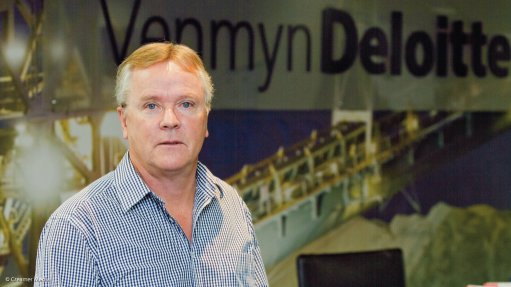
Venmyn Deloitte MD Andy Clay
Photo by: Duane Daws
JOHANNESBURG (miningweekly.com) – The mining sector should adopt some of the advanced modelling techniques that are common in the oil and gas sector, Venmyn Deloitte MD Andy Clay advocates.
Clay, who spoke to Mining Weekly Online in the attached video interview, says the oil and gas sector has some brilliant techniques for multidimensional technical assessment and believes the mining industry should take its cue from the oil and gas business in introducing more advanced modelling techniques.
He forecasts that advanced modelling methods will become more important in mining and singles out JSE- and NYSE-listed company Gold Fields as a company that is leading the way.
“If you have a look at what Gold Fields has done with its South Deep project, for instance, using sophisticated modelling to understand its orebodies, it’s not as though it can’t be done,” says Clay, who has been working in the oil and gas and mining sectors throughout his career.
As shale gas is being studied in the basins where there is primarily deep coal, he believes that South Africa’s entry into shale gas will be the turning point, because engineers will not be able to sign off on reservoir quantities in the absence of oil-and-gas-type geological modelling.
Even if it turns out that the deposits are unsuitable for shale gas exploitation, use of the modelling will provide excellent information on the coal reserves and resources, he adds.
Oil and gas sector modelling is so highly developed that three dimensional (3D) visualisation rooms allow people to ‘walk through’ orebodies.
“If you have a look at what they are doing in oil and gas, they have 3D visualisation rooms where you can physically walk through the deposit.
“It’s integrated to take into account detailed geological structure and how it impacts on the definition of reservoirs. That’s absolutely ideal for our deep coalfields.
“You have to drill and do the same type of geological modelling that you would have to do for a coal project but you need oil and gas reservoir techniques to work out the volumes,” says Clay.
The South African government has made it clear that it considers shale gas a potential energy game changer for the country but licensing issues and a lack of expertise are holding up progress.
“If you look at the way North America has embraced shale gas as a real game changer for energy, it’s gone very quickly but they’ve got all the expertise there. Here, we have a distinct lack of expertise,” he says, adding that although there has been a scramble for shale gas licences, the licensing process is currently in limbo.
Mining drillholes tend to be shallower and more numerous than oil and gas boreholes and a typical 10 000 m oil and gas drillhole can cost $100-million and is sometimes bored underwater or in other extreme conditions.
“For this reason, the oil and gas industry cannot afford not to strike oil or gas and has become much more sophisticated in its modelling techniques, which model the potential for oil and gas prior to the sinking of a drillhole,” says Venmyn Deloitte in a media release.